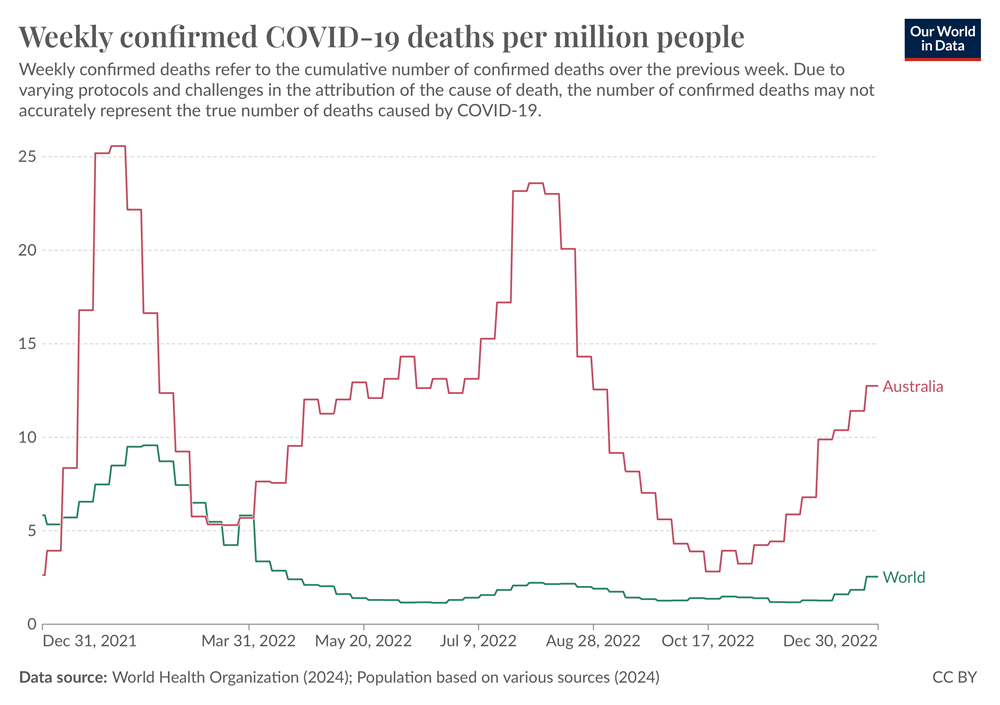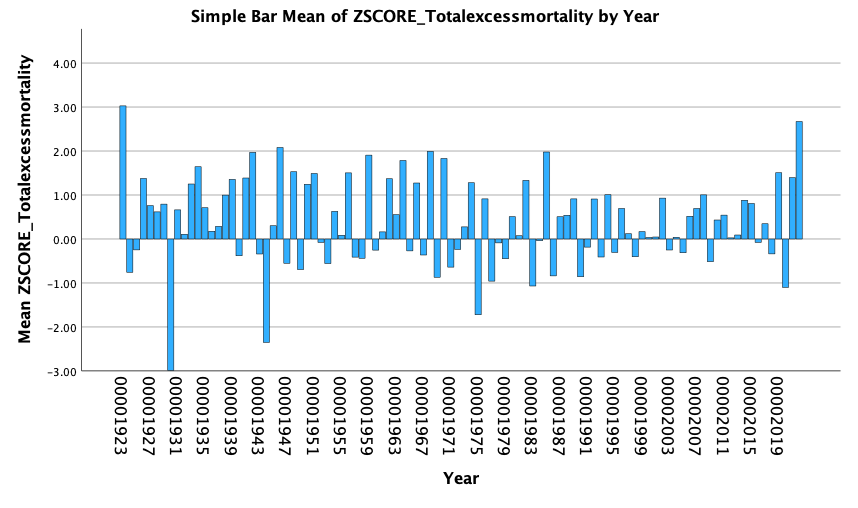‘Facts are stubborn, but statistics are more pliable.’ – Mark Twain
The year 2022 will go down in infamy as an annus horribilis. The Australian Senate Inquiry into the enormous number of excess deaths that occurred that year has concluded that the main cause was the Covid virus.
Officially, according to the Australian Bureau of Statistics (ABS), almost 20,000 extra Australians lost their lives, mainly due to the Covid virus which affected men, women, and children of all ages.
It’s important to consider that the circulating variant was Omicron, supposedly far less virulent than the original Wuhan strain, and that there is an almost universal consensus that deaths under 50 rarely occurred from Covid.
However, this graph from Our World in Data shows that mortality from Covid during 2022 was up to 14 times higher in Australia than the global average.

Our World Data
The report suggests that these excess deaths are largely explained by ‘mortality displacement’:
As Australia had lower than expected mortality in 2020, it is likely some reverse mortality displacement was experienced. This means deaths that may have occurred in 2020 had 2020 followed usual patterns of mortality, may have instead occurred in later years.
… delayed deaths from existing underlying health problems due to reduced circulation of many respiratory and other diseases in 2020 and 2021, which would have otherwise contributed to deaths in those years.
I find this explanation problematic for two reasons.
First, if these deaths were truly due to mortality displacement, as proposed, then the patterns or distribution of deaths should be similar. In particular, one would not ordinarily expect young people and children to have died in larger numbers, so why are there so many deaths amongst this population in 2022?
Second, if we consider the longer-term data we see mortality displacement cannot possibly suffice as an explanation. The ABS has published raw mortality data going back to the middle of the 19th Century. We see that mortality rates in 2020 were only 1 standard deviation (SD) below the mean whereas mortality rates in 2022 were 2.67 SDs above the long-term average.

Whilst mortality displacement could account for some of the excess mortality in 2021, it is inadequate for explaining why so many Australians died in 2022.
Another nail in the coffin to the ‘mortality displacement theory’ is that in 2019 there was also a significant excess in mortality, so it is quite illusory to suggest that the one year deficit can account for the three year surplus.
A closer examination of the graph shows that the excess mortality in 2022 was a 1 in 270 year event, exceeding all the war years combined. It was also greater than any other year since 1923.
The report acknowledges the difficulties in calculating excess mortality:
The predicted number of deaths used in excess mortality calculations is an estimate based on certain assumptions, and therefore the calculated excess mortality is also an estimate. Excess mortality can only ever be an estimate – it is not, and cannot be, a known quantity.
ABS chose instead to calculate excess deaths by considering the average of the preceding five years. This is again problematic. Mortality rates have been increasing for almost a decade and so when using this methodology, it’s inevitable that any measure of the rise in mortality will be affected by selection bias when considering the longer-term trend. (For example mortality excess in 2019 was an unusually high 1 in 15-year event.) Also, the ABS decided to exclude 2020 from the baseline calculation. Of course, this was the year of the pandemic outbreak and there were far fewer deaths than anticipated. However as mentioned, it was only 1 standard deviation below the century average, so cannot be accepted as a statistical outlier and should rightly be included in any unbiased analysis. The report also seems to have accepted the ABS methodology was perhaps sub-optimal:
While in the ABS statistics to date, ‘[p]andemic years were intentionally excluded from the baseline,’[23]the ABS stated that it will, in future, ‘produce estimates of expected mortality with COVID-19 included in the baseline’.
Never commission an inquiry you don’t already know the answer to!
It is my view that this report requires a suspension of disbelief from the reader, with a number of leaps of faith thrown in.
The report asks we accept that the unprecedented level of excess death recorded in Australia in 2022 was overwhelmingly due to the Omicron variant, a virus of little concern to most of the world, but was apparently deadly in Australia.
We are asked to believe that this variant, unlike all other versions of Covid, killed excess numbers of young men, women, and children, in a way exceptional to Australia.
We are asked to believe that the mortality rate from Omicron in Australia in 2022 was up to 14 times higher than the world average, despite Australia being one of the most prosperous countries on the planet with an advanced healthcare system.
Taken at face value, the inescapable conclusion from the report is that in 2022 Australians were badly let down by their healthcare system in the way it managed the omicron variant, given our mortality rates were so high by comparison with historical and world standards.
Having worked in healthcare around the globe I find that incredulous, but if we are to accept this then surely we should be looking to an explanation for our failure?
This points to a blind spot or lack of curiosity in the committee’s deliberations.
There appears to be little acknowledgment, awareness or remorse that we indeed are failing our people miserably. When one considers mortality rates have been on an upward trajectory for almost a decade, peaking with unprecedented numbers of deaths in 2022, one wonders whether it could possibly be any worse? I’ll leave the last words to the committee:
The committee notes the scientific nature of this inquiry, evident in the terms of reference and the subsequent evidence received via submissions, witness testimony at the public hearing, answers to questions on notice and additional information.
Whilst not a committee comprised of scientific experts, the committee reiterates its respect of the scientific process, legitimate scientific and medical institutions, as well as government agencies and officials, whose submissions and testimony have illustrated that COVID-19 was the key contributing factor to excess mortality from 2021–2023.
Dr David Richards, Australians for Science and Freedom

























